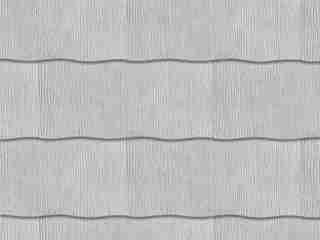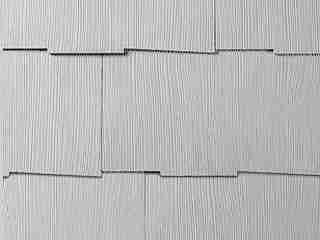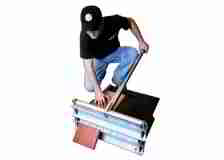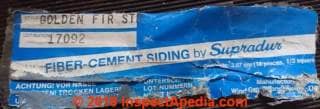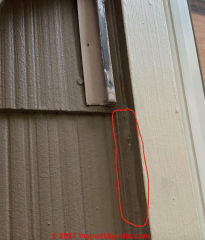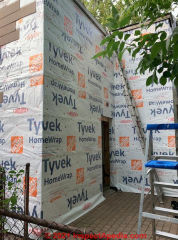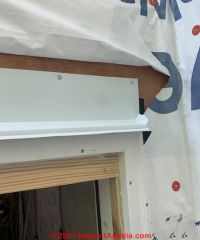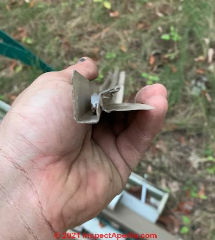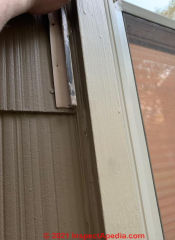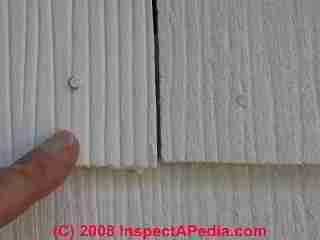 Sources of Replacements for Asbestos-Cement Wall Siding & Fiber Cement Roof Shingle Cutters
Sources of Replacements for Asbestos-Cement Wall Siding & Fiber Cement Roof Shingle Cutters
- POST a QUESTION or COMMENT about where to get replacement materials for asbestos cement siding shingles & tools for repair work
Where to buy replacements for asbestos cement shingle siding:
This article explains why, where & how to obtain replacement non-asbestos fiber cement shingles to repair or replace asbestos cement shingle siding.
InspectAPedia tolerates no conflicts of interest. We have no relationship with advertisers, products, or services discussed at this website.
- Daniel Friedman, Publisher/Editor/Author - See WHO ARE WE?
Sources of Replacements Asbestos & Fiber Cement Wall Shingles
Contemporary cement asbestos product manufacturers make reinforced fiber-cement wall and roofing shingles and other products which look like, perform similarly to, and need to be installed similarly to the original asbestos-cement shingles - but these new products are free of asbestos.
Modern replacements for asbestos cement wall siding products are reinforced with a variety of fibers including fiberglass. Other replacements for asbestos-cement siding use both different fibers and a different aggregate (perlite) to replace the asbestos.
Some of the substitute products have been in use for more than 30 years (2008).
GAF's WeatherSide® fiber cement siding is a perfectly-matching replacement for older asbestos-cement or fiber cement products orginally produced by Supradur, and is sold in the three standard patterns illustrated here.
The three most-common current and traditional fiber cement siding patterns are all wood-grain surace-patterned products in three different bottom-edge designs: straight (shown at the top of this page), wavy (shown at left), and thatched (shown below).
Contemporary cement asbestos product manufacturers make reinforced fiber-cement wall and roofing shingles and other products which look like, perform similarly to, and need to be installed similarly to the original asbestos-cement shingles - but these new products are free of asbestos.
Modern replacements for asbestos cement wall siding products are reinforced with a variety of fibers including fiberglass. Other replacements for asbestos-cement siding use both different fibers and a different aggregate (perlite) to replace the asbestos. Some of the substitute products have been in use for more than 30 years (2008).
GAF's WeatherSide® fiber cement siding is a perfectly-matching replacement for older asbestos-cement or fiber cement products orginally produced by Supradur, and is sold in the three standard patterns illustrated here. The three most-common current and traditional fiber cement siding patterns are all wood-grain surace-patterned products in three different bottom-edge designs: straight (shown at the top of this page), wavy, and thatched (shown below).
Where to Buy Replacements for Asbestos-Cement or other Fiber Cement Wall Siding
For maintenance or replacement of asbestos-cement wall siding or roof shingles (or wall siding) contact the GAF Premium Products Corporation or look for the company's WeatherSide® fiber cement siding at Home Depot® stores.
The original producer of asbestos cement and later fiber cement siding, Supradur Manufacturing Corporation, was liquidated in bankruptcy proceedings and sold to GAF Premium Products, Corp. on 20 July 1995. GAF, principally a producer of roofing products also continues to produce and distribute fiber cement siding (WeatherSide® fiber cement siding). The company can be contacted at
GAF Premium Products, Corpo., 440 Katherine Rd Wind Gap, PA, 18091 United States (610) 863-4101 http://www.gaf.com
According to the company's website:
WeatherSide™ fiber cement siding contains NO asbestos
and the current fiber cement siding product available from GAF is
Virtually identical in size and shape to millions of old non-existent siding shingles installed over the last 50 years. and
WeatherSide™ fiber cement siding meets or exceeds UL approved non-combustible testing (ASTM E136 & UL 723)
Current fiber cement wall siding from GAF in the three edge-designs shown above is provided in three different versions that offer different thicknesses, exposures or weights as summarized in our table just below.
| Table of Modern Fiber Cement Shingle Type Siding Product Specifications | |||
|---|---|---|---|
| GAF Shingle Model | Dimensions | Exposure | Weight Lbs/Square |
| Purity™ Straight / Wavy Edge | 12" x 24" x 11/64" thick | 11" | 168 lbs |
| Purity™ Thatched Edge | 12" x 24" x 11/64" thick | 10 1/2" | 186 lbs |
| Profile™ Straight Edge | 9" x 32" x 11/64" thick 12" x 24" x 11/64" thick 14 5/8" x 32" x 11/64" thick |
8" 11" 13 5/8" |
177 lbs 165 lbs 171 lbs |
| Emphasis™ Thatched Edge Extra Thick | 14 5/8" x 25" x 9/32" | 13" | 268 lbs |
Notes to the table above
Source: GAF Products Corporation, retrieved 8/20/2013, original source: http://www.gaf.com/Other_Building_Products/Siding/WeatherSide_Fiber_Cement_Siding
Up to 1995 contractors could contact Supradur Manufacturing Corporation, PO Box 908, Rye NY 10580 800-223-1948, or from within New York State, 914-967-8230 to purchase Supradur® mineral fiber shingles.
Thanks to reader Terry Jones, a roofing wholesaler at Roofing Wholesale, Inc., Phone 800.282.4737, Fax 614.486.7817 , for the Supradur to GAF sale update (8/20/2013).
Replacement for Asbestos-Cement Roof Shingles
One manufacturer of cement-asbestos shingles was Ruberoid Co., who made 8" x 16" tapered singles with a surface pattern resembling wood and called "Ru-Ber-Oid-Eternit Tapered Timbertex Asbestos-Cement Shingles." 260 singles/525 lbs/square, were available in a wide range of colors.
For handling and disposal guidance concerning old cement-asbestos wall siding material contact the US EPA, your state Department of Environmental Protection/Conservation, or your local building and health departments.
Sources of Tools for Cutting Fiber Cement Shingles: Roofing Shingles or Wall Siding Shingles
Watch out: However very old, weathered and worn asbestos cement shingles, such as on a roof or sometimes on a wall that has been painted and is peeling, or roofing or wall cement asbestos shingles that are mishandled during demolition (breaking into many small pieces, running hand or power saws to cut the material) risks creating airborne asbestos-contaminated dust which could be a health and environmental hazard.
When we installed asbestos cement shingle siding we rented a guillotine chopper that cut the material while producing a minimum of dust.
A modern version of this fiber cement cutter that is hand-lever operated and does not require electricity is the Bullet Tools 920 Pro Magnum Shear I-20 Electricity Free 20 Inch Flooring and Siding Dust Free Cutter (photo at left) - this is a great tool, but a bit steep for a homeowner or do-it-yourselfer at around $900.
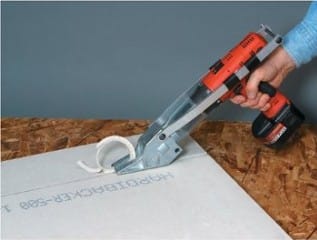
A modern fiber cement shingle cutting tool used for the same purpose is the Malco® TSFC Tubo Shear fiber cement cutting tool also used to cut cement backerboard and similar products.
The Malco fiber cement and backerboard shear is powered by a separate cordless or wall-power connected electric drill.
Malco also produces the TSF2A, a heavy-duty pneumatic shear cutting tool for the same purpose.
Similar shear tools are produced by quite a few other manufacturers including the tools listed below.
At Reviewers (scroll down past the links) we list sources to purchase these tools.
- Makita JS8000 Fiber Cement Shear Kit (variable speed)
- Kett 1/2 Capacity Steel Shear Head #93 20, (this is just the head, needs to be attached)
- Kett Electric Fiber Cement Cutting Shears - 120 Volt, 5 Amp, Model# KD-29
- Kett Fiber Cement Shears KD 1495 (drill powered,
- Snapper Inc SS204 Fiber Cement Siding Shear Hardi Board cutter.
Added demolition and disposal cost of cement-asbestos products
Also in some communities special measures and added costs are involved because of a requirement for air-testing during removal and possibly costs to dispose of the material in an appropriate landfill. (After all, originally this material came from the land.)
Thanks to reader Van Moore for technical editing and requesting clarification.
Painting Cement Asbestos Building Siding
Should I paint my asbestos cement shingles? Do you need to use special paint for cement asbestos siding?
Painting cement asbestos siding or non-asbestos fiber cement siding is in part a cosmetic decision. We have rarely seen this material in a worn, friable condition, but should that occur, one might paint the surface also to stop fiber shedding and to preserve the material.
And of course fiber cement products such as those sold hy GAF (Sources of Replacements for Asbestos Cement Shingles) come with a factory-applied primer intended to be "ready for painting".
Fiber cement shingles, both new non-asbestos product and the older asbestos-cement product are provided from the manufacturer with a coated surface, usually white. When the asbestos cement siding is soiled or moldy or has an algae coating we prefer to gently clean the surface with a sprayer, perhaps a deck cleaner solution.
Watch out: If you use a power washer be careful to spray "down" (to avoid blowing water into the building walls) and to keep far enough away that you do not damage the siding or "rough it up" which may cause more rapid deterioration or even fiber or asbestos release.
But sometimes the asbestos cement or fiber cement shingles just look soiled and do not clean up enough to satisfy the homeowner. In general, this siding material can be painted using normal house paints.
Check with your paint suppliers because some paints may not be recommended for the surface. Be sure to use both a primer and top coat that are recommended for use on cleaned fiber cement siding as recommended by the manfacturer of both the siding and the paint.
Then be sure that the siding is dry before applying either primer or paint.
Watch out: But once you paint the fiber cement or asbetsot cement siding, you've converted a "no maintenance" surface into one that will occasionally need to be re-painted for cosmetic reasons.
On a home we maintained for nearly 20 years, the factory-applied original coating endured perfectly well whereas neighboring homes of the same age and using the same siding but that had been painted required re-painting from time to time.
Current Sources of Fiber Cement Replacements for Asbestos Cement Siding & Shingles
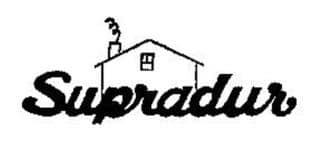 Perhaps the best-known name among asbestos cement roofing and siding was and remains Supradur™ discussed below.
Perhaps the best-known name among asbestos cement roofing and siding was and remains Supradur™ discussed below.
Another manufacturer of cement-asbestos shingles was Ruberoid Co., who made 8" x 16" tapered singles with a surface pattern resembling wood and called "Ru-Ber-Oid-Eternit Tapered Timbertex Asbestos-Cement Shingles." 260 singles/525 lbs/square, were available in a wide range of colors.
Contemporary roofing product manufacturers make reinforced fiber-cement roofing shingles and other roofing products which look like, perform similarly to, and need to be installed similarly to the original asbestos-cement shingles - but these new products are free of asbestos.
The replacements for asbestos cement roofing products are reinforced with a variety of fibers including fiberglass.
Other replacements for asbestos-cement roofing use both different fibers and a different aggregate (perlite) to replace the asbestos. Some of the substitute products have been in use for more than 30 years (2008).
Watch out: field performance of some non-asbestos-containing fiber cement products, at least on roofs, has been reported to be poor. See the reference articles given below.
- Supradur Manufacturing Corporation, Supradur® mineral fiber shingles. Supradur Manufacturing Corp., PO Box 908, Rye NY 10580 800-223-1948, or from within New York State, call 914-967-8230.
Notice: As a result of the financial cost to respond to product liability and warranty claims, Supradur™, a manufacturer of asbestos-cement roofing and siding products since 1947, filed for protection under Chapter 11 of the U.S. federal bankruptcy code on 30 March 1995.
Supradur switched from asbestos-containing to asbestos-free products between 1989 and 1992. There were, unfortunately, also product failure and warranty claims for Supradur's non-asbestos fiber cement products as well.
As a result of the sale of Supradur to GAF in July 1995, Supradur no longer owned its manufacturing operations and could no longer honor warranties applicable to its products. GAF will warrant products sold after 20 July 1995. - (Good 1995)
GAF Materials Corporation, GAF Premium Products, Inc., purchased the Supradur Manufacturing Corporation effective 20 July 1995, GAF will warrant products sold after July 20, 1995.
Notice: on 7 January 2001 GAF filed for protection under Chapter 11 of the U.S. Bankruptcy Code from liabilities resulting from asbestos-related bodily injury claims in 2001.
This bankruptcy filing was ascribed to liability costs emerging from GAF's purchase of Ruberoid whose product line included many asbestos-containing products including roofing and siding shingles and an asbestos mine in Vermont. (The Vermont mine had been shut down in 1975). GAF emerged from bankruptcy in 2009 and had at that time discharged its asbestos-related liabilities.
Supradur brands and trademarks include both currently-available non-asbestos products and trademarks associated with asbestos cement products. Some of these, such as Supradur™ have expired. Here is the full list:
Alas metal channels for siding shingle retention, California Rancho siding shingles, Ceda-Tones siding shingles, Fiber Cement siding shingles, Fiber-Shake sidewall shingles, Fireboard fireproof insulating sheets used behind or under stoves, at fireplaces, etc., Heavytex siding shingles, Shado-Shake asbestos-cement siding and roofing shingles, Supra-Crylic asbestos-cement siding shingles, Supra-Durable asbetsos cement siding and roofing shingles, Supradur asbestos-cement roofing and siding shingles, Supra-Slage roofing shingles, Supraseal roofing shingles, Supranyl (vinyl siding),
Supra-Slate "looks like slate and is manufactured in colors of real quarry slate." Tegusol is a double interlocking clay roof tile. Available from: Supradur Manufacturing Corporation, PO Box 908, Rye, NY 10580 800/223-1948 or 914/967-8230. or 122 East 42nd St., NY, NY 10168 212/697-1160
For handling and disposal guidance concerning old roofing material contact the US EPA, your state Department of Environmental Protection/Conservation, or your local building and health departments.
- Eternit, Inc., rigid fiber reinforced cement roofing slates (and board products. Village Center Drive, Reading, PA 19607 800/233-3155
- Lifetile® Boral Concrete Products, Inc., produces high density extruded concrete roofing tiles meeting Class "A" requirements. Dallas, TX 214/544-2227
- Reinforced-cement shingles which "look like slate but are lighter and one-third the cost" are available from Atlas International Building Products, 5600 Hochelaga St., Montreal, Quebec, Canada H1N 1W1. [$180/square loose or $400./sq. installed, 30-year guarantee.]
Non-asbestos fiber cement roof shingles, slate lookalikes, & siding replacements
- Singer, Penny, "Asbestos-Free Slate That Isn't Quite Slate", The New York Times, 1 May 1994, online at http://www.nytimes.com/1994/05/01/nyregion/asbestos-free-slate-that-isn-t-quite-slate.html
Excerpt:
"When we decided to stick it out, we were fortunate in finding several talented people who had left large companies and were eager to work on such a problem," Mr. Netter said.
"Eventually, after an awful lot of research and technology, they found a solution.
By substituting Brazilian eucalyptus fibers and impregnating them with a sila fume, a byproduct of electric-furnace steel making, they came up with a product even stronger than the original but with the same flexibility."
... Supradur's products, Supra Slate II and Heritage Slate, look and feel enough like real slateto satisfy architects and others involved in designing expensive houses. - ASBESTOS CEMENT ROOF REPAIR - Durability, life expectancy of & replacements for asbestos cement & fiber cement roofing.
- SLATE ROOF SOURCES & TOOLS - includes sources for both traditional slate and synthetic slate substitutes
Durability of Supradur™ Fiber Cement (non-asbestos) products
- ASBESTOS CEMENT [ROOF] SHINGLES [PDF], retrieved 2018/01/11, original source: http://www.pic.int/Portals/5/en/DGDs/Alternatives/USA/American%20alternatives%20part%205.pdf
Excerpt: While insisting that all products sold by Supradur exceeded the ASTM Standard Specification for Non-Asbestos Fiber Cement Roofing Shingles, Shakes, and Slates, ASTM C 1225-95, Mr. Netter acknowledged that the asbestos-free products did not exhibit the same levels of strength and flexibility as the previously manufactured asbestos-containing products.
Cracking failures of these shingles, relatively soon after application, have been reported in different parts of the country, even though these products reportedly met the current ASTM criteria. According to a Supradur representative attending a recent ASTM meeting, Supradur had assumed that if it manufactured a product that complied with the ASTM standard the product would perform satisfactorily in the field.
While acknowledging that there were problems with Supradur's asbestos-free products, Mr. Netter also said that Supradur believed that in some instances methods of installation and foot traffic had contributed to the problem of shingle cracking because contractors assumed that the new products had the same strength and flexibility as the asbestos-containing products. Mr. Netter said that Supradur had dramatically improved product strength in recent years. - Good, William A., CAE, “SPECIAL REPORT on the PURCHSSE of SUPRADUR MANUFACTURING CORPORATION by a subsidiary of GAF MATERIALS CORPORATION”, [PDF] - National Roofing Contractors Association (NRCA), (August 1995), Retrieved 2018/01/11, Original source: http://docserver.nrca.net/technical/supr0895.pdf
...
Reader Comments, Questions & Answers About The Article Above
Below you will find questions and answers previously posted on this page at its page bottom reader comment box.
Reader Q&A - also see RECOMMENDED ARTICLES & FAQs
Question: do Supradur™ Fiber Cement Siding Shingles Contain Asbestos?
At my house are the following plates. In the Internet research, I came to your site.
Can you tell me if these plates are asbestos-containing? The house was built in 1955. The plates were assembled around 1985. ... - Anonymous by private email 2018/01/10
Reply: When did Supradur™ stop using Asbestos in Roofing & Siding Products?
For Supradur™ fiber cement shingle siding made and installed in 1985 it is likely that your siding does contain asbestos.
Supradur™ began to switch from asbestos-cement products to asbestos-free fiber cement product manufacturing in 1989.
By February, 1992, Supradur had completely converted to asbestos-free production. - (Good 1995)
In 1986, a year after your siding was installed, Supradur remained as the sole producer of asbestos-cement siding products as other companies had already left the field.
Asbestos-cement siding shingles resemble shakes or machine-grooved shingles and asbestos-cement roofing shingles generally resemble either shakes or slate (Supradur 1985). They are primarily being used for replacement and maintenance in luxury homes, schools, churches, and historical restoration projects (Atlas 1986b, Supradur 1986a). Of three domestic producers in 1981, only one, Supradur, remains in 1986. Production has declined 34 percent from 266,670 squares in 1981 to 176,643 squares in 1985 (ICF 1986, TSCA 1982).
Only one company, Atlas International Building Products (AIBP) of Montreal, Quebec, Canada is known to import asbestos-cement shingles into the U.S. (Atlas l98Ga, Atlas l986c).
There are no substitutes for asbestos-cement shingles for maintenance and repair applications because no substitute products resemble the asbestos product closely enough to replace it in part (National Roofing Contractor’s Association 1986, Supradur 1986b).
However, there are many adequate substitutes that can be used for complete replacement, remodeling or in new construction. - ASBESTOS CEMENT SHINGLES, [PDF] p. 14
The original Supradur™ wordmark trademark was filed in the U.S. on 3 October 1985, after asbestos cement siding products had ceased manufacture. - https://trademarks.justia.com/735/61/supradur-73561285.html
A later Supradur™ trademark was filed on March 30, 1993, well after asbestos cement siding products had ceased manufacture. - https://trademarks.justia.com/743/73/supradur-74373264.html
On the packaging photo that you provided that the company used the term "fiber cement siding" not "asbestos cement siding" as the older asbestos-containing products were typically called.
As the shift from asbestos- to non-asbestos- containing fiber cement products at Supradur occurred between 1989 and 1992, specific products made during that interval might also contain asbestos.
On 2021-10-13 by inspectapedia.com.moderator (mod) - why use vertical inset trim at corners where asbestos-cement or fiber cement shingle siding is installed?
@Ben,
I see it now.
That looks to me as if someone thought they could cover the butt joint between the fiber cement siding in the vertical Trend by just jacking up another little piece of trim molding. I agree with you, that is it seems to me it would been better just to seal the joint with an appropriate caulk or sealant.
If you carefully pull that trim off, be careful not to break the FC siding, perhaps you'll see that there were some rather large end gaps and someone thought that sealant wouldn't be enough.
On 2021-10-12 by Ben
@inspectapedia.com.moderator, The channel I'm holding up is from another window. The existing channel is there (circled in red) but harder to see. I agree, I don't think there's a reason for it. It's just another joint to caulk as far as I'm concerned.
On 2021-10-12 by inspectapedia.com.moderator (mod)
@Ben,
Thanks that's a helpful question.
In our OPINON
1. We never like to use horizontal furring behind siding as it wants to trap water against the building sheathing; a rain-screen wants to be able to drain vertically down to an exit point at the bottom of the siding.
(perhaps I've misunderstood you ?)
See WATER BARRIERS, EXTERIOR BUILDING
This article explains the need for water resistant barriers on building exterior walls and explains the concept of a rain screen.
and see RAIN SCREEN PRINCIPLES
2. Back-Priming fiber-cement siding: should be harmless and might improve the product life but again in a mere OPINON, it's probably not necessary (gilding the lilly); - I've worked with asbestos-cement shingles installed in the 1940s that have been exposed to the weather ever since - now for 80 years - that were not back-primed and that were very durable and had suffered no water damage; the primary damage I found was usually mechanical - breakage.
And at least some manufacturers (James Hardie) have specifically said that back-priming is not necessary for their fiber-cement products; the manufacturing process for FC siding includes both binders and other additives that permeate the entire thickness of the siding shingles or boards and that improve its weather / moisture resistance (and may also have been added to improve the bonding of surface paint on the weather-side).
The JLC - Journal of Light Construction as a nice Q&A on this point by Mark Parlee (2009): https://www.jlconline.com/how-to/foundations/back-priming-fiber-cement-siding_o [full disclosure: though not on this topic we've worked with JLC editors for decades and have on occasionally contributed to that publication]
Do correct me if I've misunderstood, but from what I see in your last photo there is no reason for that metal J-channel -
the siding butts into the vertical trim and is sealed there.
That sort of J-channel would more-likely be used if someone were installing another siding material over the original.
On 2021-10-12 by Ben
TL;DR
1. Opinion on placing coroplast strips ripped horizontally (to allow drainage) behind each successive course for a type of rainscreen.
2. Opinion on priming (and maybe even painting) BOTH sides of the old asbestos siding before it goes back on the wall.
Thank you so much - this website has lots of useful info!
On 2021-10-12 by Ben - China-Glaze Long Length Clapboard" by US Gypsum Company - 8.8" by 56"
Hope you can have some input for me on this - the photo sort of shows the whole scope, that entire back and side walls were rotted over the years since this is a north-west corner with a giant tree above it. Now that I fixed everything and have the new wrb on the sheathing on both those walls, everything is super tight compared to before.
So I am wondering if it would be a good idea to NOT nail the siding back on directly over the house wrap and instead put in horizontally ripped 2in wide coroplast (the corrugated stuff they use to make signs) furring strips under where each successive course of shingles terminates horizontally. ie a sort of a rainscreen just to provide some space there to break the water capillary action because with the new wrap I think the sheathing-wrap-siding interface will have have a harder time drying to the outside. (I live in western NY...so we get all 4 seasons).
The coroplast is only 3/16, so I don't really have to worry about the siding sticking out and making problems with the pvc trim. at the very bottom row, I'd put like 3 layers of the coroplast wrapped in insect screen. Is there any reason this is a bad idea with this asbestos siding?
ps - I also plan to prime both sides of the siding before it goes back up. All sorts of nasty beating it too over the years from water damage on the inside side. Maybe I'll even paint both sides before putting it back up. This way I have solid water protected siding from both sides with a small gap between the wrap and siding to promote drying if anything does get past the siding. I will caulk and tar-strip flash each of the butt joints.
Just a little detail of the head flashing I put it. There was no head flashing from before - just a wooden drip cap. For this I ripped a pvc at an angle, put on top of the brick moulding, and the new flashing I bent sits on top of that. I just don't know how to go about siding around those end dams.
Perhaps just a notch in the siding and slip it right over?
Here's the profile they used in the corners. Now, in the process of ripping it all down these are basically useless. I think I'll rip a 1x1 from a pvc board and use that for the corner.
@inspectapedia.com.moderator, It's just regular 9 inch asbestos board - nothing special as I see that would necessitate those aluminum J channels. Maybe the installers did it for the look.
In the first photo [below] I'm holding up a piece from another window next to an installed on. The back was nailed to the sheathing and the side butted tight agaisnt the brick moulding.
On 2021-09-16 by inspectapedia.com.moderator (mod) - Installing China-Glaze Long Length Clapboard" asbestos-cement shingles
From our article SIDING WOOD SHINGLE INSTALLATION https://inspectapedia.com/BestPractices/Wood_Shingle_Installation_Specifications.php
You can see this example of a vertical strip that gives a uniform vertical edge against which to abut siding, whether it's of FC boards or shingles.

You could really help us out here with some sharp photos of your siding as installed, your siding in the box, showing both sides and an end profile, and photos of all of the printed information on the box.
You can post one photo per comment but as many comments as you like.
On 2021-09-16 by inspectapedia.com.moderator (mod)
@Ben,
There is and was no backer board (insulating board) requirement when installing fiber cement siding; rather, the siding was most-often installed over roofing felt or another house-wrap product and nailed through it to the exterior sheathing of plywood or tongue-and groove boards.
I have not seen J-channel used with fiber cement siding and am not sure of its benefit when used vertically; most-often the fiber cement siding was caulked around the windows and doors and at corner boards at the building corners.
At an inside corner a nice detail is to install a vertical wood strip in the corner. Then you can end-butt each fiber cement siding segment against that wood strip. That avoids the problem that otherwise occurs because the siding boards or shingles themselves will be slightly pitched on the building wall - an effect of their overlap.
For other readers, China Glaze was a trademarked name for a cement-asbestos siding shingle filed by U.S. Gypsum and trademarked in 1962.
On 2021-09-15 by Ben
My house is sided with "China-Glaze Long Length Clapboard" made by US Gypsum Company - 8.8" by 56" as per a left-over box. Every inside corner and around all windows, they used a J-channel.
There is no backer board, the only thing between the siding and plywood sheathing is a two layer system of some sort of thick paper and a "foil-like" wrap over that. Wondering if you've seen installations without backer boards?
Also, are the J channels something that's necessary or you've seen before? If I don't use J channels on inside corners, how do I make a neat transition in the inside corner where the siding pieces meet?
On 2020-09-25 by (mod) - where to purchase replacement fiber cement siding or roofing
Sorry we didn't make it obvious enough - you missed purchase information in the article above, Anon.
The article above includes manufacturer contact information and sources for replacements for asbestos cement shingles or siding, and also you can simply
see SLATE ROOF SOURCES & TOOLS - includes sources for both traditional slate and synthetic slate substitutes
On 2020-09-25 by Anonymous
Are you kidding me all that read to fine out NO answer a place to purchase I'm 1995?
On 2020-07-01 - by (mod) -
Kenneth,
Supradur (above) may have what you want
Or
Take a sample to your local building supplier and i think you'll find a close match.
On 2020-06-30 by Kenneth Landry
I have Spradur Asbestus siding on my house and need replacement corner molding. These are corner strips of aluminum about one foot long to match the siding. Where can I find these pieces?
On 2018-04-25 - by (mod) -
Thank you for the suggestion. We do list the manufacturers of asbestos products including fiber cement and asbestos cement and transite products in
ASBESTOS PRODUCING COMPANIES - https://inspectapedia.com/hazmat/Asbestos_Producing_Companies.php
a master index to asbestos product manufacturers found at this website.
You will see there, as we list the products produced by these companies, that manufacturers of asbestos cement products never confined themselves to "transite asbestos panels" a term that is inaccurate.
More accurate would be the term asbestos-cement products or cement-asbestos products that included such items as
- asbestos-cement shingle siding
- asbestos-cement roof shingles
- corrugated asbestos cement panels used as roofing, siding, cooling tower panels
- transite pipe (asbestos cement pipe) used in drainage, HVAC ducts, even chimney flues
- asbestos cement flat or smooth panels used as fire-resistant wall and ceiling coverings in boiler rooms
You'll also want to see
ASBESTOS CEMENT ROOF & SIDING HISTORY https://inspectapedia.com/exterior/Asbestos_Cement_Siding_Roofing_History.php
Some of the significant producers of asbestos cement products that included siding and roofing include
Certainteed
Fiberboard Corporation later acquired by Owens Corning Corp.
Flintkote
James Hardie Corp.
Johns Manville Corporation
National Gypsum Corporation
Ruberoid Flintkote
U.S. Gypsum Corporation
But the most-extensive list is in the first article we cited just above.
On 2018-04-24 by David Green
Manufacturer name if Transite asbestos panels an asbestos cement panels. Website would be nice.
Thanks for any help.
David F. Green
On 2017-12-07 - by (mod) -
Sarah,
at
ASBESTOS CEMENT ROOF REPAIR - https://inspectapedia.com/roof/Asbestos_Cement_Shingle_Maintenance.php
we cite this source
Supradur Manufacturing Corporation, PO Box 908, Rye NY 10580 800-223-1948, or from within New York State, call 914-967-8230.
I've added more sources into the bottom of the article above.
On 2017-12-07 by Sarah
Where can I purchase Supradur ll slate shingles (asbestos free)?
I need to replace some of my roof shingles which were made by Supradur. I belive they are the asbestos free Supradur ll.
On 2017-02-25 - by (mod) -
Small chips in fiber cement or asbestos fiber cement siding, because they are on the building exterior, and because the material is cementious, are unlikely to produce a measurable Hazard for you. Of course large areas of damage, or grinding, sign, or demolition of that same siding material would require special measures. -
On 2017-02-25 by C Apollo
house was built in 1973. GAF siding . How do we tell if it is asbestos. If it is chiping on the edges in some areas is this dangerous if it is asbestos
...
Continue reading at ASBESTOS ROOFING / SIDING DUST or select a topic from the closely-related articles below, or see the complete ARTICLE INDEX.
Or see
Asbestos-Cement Siding Articles
- ASBESTOS CEMENT PRODUCTS
- ASBESTOS CEMENT SIDING - home
- ASBESTOS DISPOSAL REGULATIONS
- ASBESTOS & FIBER CEMENT ROOFING - home
- ASBESTOS IDENTIFICATION IN BUILDINGS - home
- ASBESTOS REMOVAL, WETTING GUIDELINES
- FIBERBOARD ROOFING & FIBER-WOOD ROOFING - home
- PERMA-STONE EXTERIORS
- SIDING ASPHALT SHINGLE or SHEET - some asphalt shingle products contain asbestos too
- SIDING, FIBER CEMENT - newer non-asestos cement-based siding
- STONE VENEER WALLS - some permastone products contain asbestos
Suggested citation for this web page
ASBESTOS CEMENT SIDING REPLACEMENT at InspectApedia.com - online encyclopedia of building & environmental inspection, testing, diagnosis, repair, & problem prevention advice.
Or see this
INDEX to RELATED ARTICLES: ARTICLE INDEX to ASBESTOS HAZARDS
Or use the SEARCH BOX found below to Ask a Question or Search InspectApedia
Or see
INDEX to RELATED ARTICLES: ARTICLE INDEX to BUILDING SIDING
Or use the SEARCH BOX found below to Ask a Question or Search InspectApedia
Ask a Question or Search InspectApedia
Try the search box just below, or if you prefer, post a question or comment in the Comments box below and we will respond promptly.
Search the InspectApedia website
Note: appearance of your Comment below may be delayed: if your comment contains an image, photograph, web link, or text that looks to the software as if it might be a web link, your posting will appear after it has been approved by a moderator. Apologies for the delay.
Only one image can be added per comment but you can post as many comments, and therefore images, as you like.
You will not receive a notification when a response to your question has been posted.
Please bookmark this page to make it easy for you to check back for our response.
IF above you see "Comment Form is loading comments..." then COMMENT BOX - countable.ca / bawkbox.com IS NOT WORKING.
In any case you are welcome to send an email directly to us at InspectApedia.com at editor@inspectApedia.com
We'll reply to you directly. Please help us help you by noting, in your email, the URL of the InspectApedia page where you wanted to comment.
Citations & References
In addition to any citations in the article above, a full list is available on request.
- Asbestos products and their history and use in various building materials such as asphalt and vinyl flooring includes discussion which draws on Asbestos, Its Industrial Applications, D.V. Rosato, engineering consultant, Newton, MA, Reinhold Publishing, 1959 Library of Congress Catalog Card No.: 59-12535 (out of print).
- "Handling Asbestos-Containing roofing material - an update", Carl Good, NRCA Associate Executive Director, Professional Roofing, February 1992, p. 38-43
- EPA Guidance for Controlling Asbestos-Containing Materials in buildings, NIAST, National Institute on Abatement Sciences & Technology, [republishing EPA public documents] 1985 ed., Exposure Evaluation Division, Office of Toxic Substances, Office of Pesticides and Toxic Substances, U.S. Environmental Protection Agency, Washington,D.C. 20460
- EPA, ASBESTOS IN YOUR HOME [PDF] - U.S. EPA, Exposure Evaluation Division, Office of Toxic Substances, Office of Pesticides and Toxic Substances, U.S. Environmental Protection Agency, Washington,D.C. 20460
- NRCA Roofing and Waterproofing Manual, 4th Ed., available from the National Roofing Contractors' Association.
- "Tips for working with fiber-cement roofing products", Thomas L. Smith, AIA, RRC, Professional Roofing, September 1996
- Bullet Tools 920 Pro Magnum Shear I-20 Electricity Free 20 Inch Flooring and Siding Dust Free Cutter -(sold at Amazon and at other tool distributors) this is a great tool, but $900. http://www.bullettools.com/ Bullet Tools Company, 3390 W. Hayden Ave., Hayden ID 83835 - 800-406-8998 or international: 208-772-0175. sales@bullettools.com
- Malco® TSFC Tubo Shear fiber cement cutting tool (sold at Amazon and at other tool distributors) and also the Malco TSF2A Shear Cutting Tool, a heavy-duty pneumatic shear cutting tool for the same purpose (available at Amazon.com) Malco Products, http://www.malcoproducts.com/ specializes in producing tools for the HVAC trade. Malco Products, Inc. - PO Box 400, 14080 State Highway 55 NW, Annandale, MN 55302-0400 P: 800-328-3530 | F: 320-274-2269
- Makita JS8000 Fiber Cement Shear Kit (variable speed) (sold at Amazon and at other tool distributors)
- Kett 1/2 Capacity Steel Shear Head #93 20 - (sold at Amazon and at other tool distributors)
- Kett Electric Fiber Cement Cutting Shears - 120 Volt, 5 Amp, Model# KD-29 - (sold at Amazon and at other tool distributors)
- Kett Fiber Cement Shears KD 1495 (drill powered)- (sold at Amazon and at other tool distributors)
- Snapper Inc SS204 Fiber Cement Siding Shear Hardi Board cutter.- (sold at tool distributors)
- Thanks to reader Van Moore for suggesting clarification of our text on how cementious asbestos-containing materials become friable and unsafe 4/15/2010
- June 1997 - Window Putty - OSHA case cites contractor for asbestos exposure during removal of window putty http://www.osha.gov/pls/oshaweb/owadisp.show_document?p_table=NEWS_RELEASES&p_id=1091
- Asbestos products and their history and use in various building materials such as asphalt and vinyl flooring includes discussion which draws on ASBESTOS, ITS INDUSTRIAL APPLICATIONS, ROSATO 1959, D.V. Rosato, engineering consultant, Newton, MA, Reinhold Publishing, 1959 Library of Congress Catalog Card No.: 59-12535 (out of print, text and images available at InspectAPedia.com).
- "Handling Asbestos-Containing roofing material - an update", Carl Good, NRCA Associate Executive Director, Professional Roofing, February 1992, p. 38-43
- EPA Guidance for Controlling Asbestos-Containing Materials in buildings, NIAST, National Institute on Abatement Sciences & Technology, [republishing EPA public documents] 1985 ed., Exposure Evaluation Division, Office of Toxic Substances, Office of Pesticides and Toxic Substances, U.S. Environmental Protection Agency, Washington,D.C. 20460
- In addition to citations & references found in this article, see the research citations given at the end of the related articles found at our suggested
CONTINUE READING or RECOMMENDED ARTICLES.
- Carson, Dunlop & Associates Ltd., 120 Carlton Street Suite 407, Toronto ON M5A 4K2. Tel: (416) 964-9415 1-800-268-7070 Email: info@carsondunlop.com. Alan Carson is a past president of ASHI, the American Society of Home Inspectors.
Thanks to Alan Carson and Bob Dunlop, for permission for InspectAPedia to use text excerpts from The HOME REFERENCE BOOK - the Encyclopedia of Homes and to use illustrations from The ILLUSTRATED HOME .
Carson Dunlop Associates provides extensive home inspection education and report writing material. In gratitude we provide links to tsome Carson Dunlop Associates products and services.


